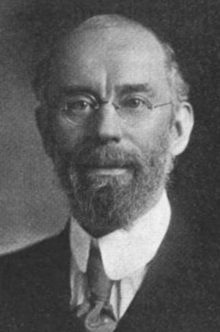Charles Leonard Bouton (April 25, 1869 – February 20, 1922) was an American mathematician.
Early life and education
Charles L. Bouton was born in St. Louis, Missouri, where his father was an engineer. He studied in the public schools of St. Louis. He later received a Master of Science degree from Washington University in St. Louis. In 1898 he received his doctorate from Leipzig University. His Ph.D. advisor was Sophus Lie.
He married Mary G. Spencer in Baltimore on June 15, 1907.
Teaching
He taught at the Smith Academy, Washington University and Harvard University. From 1900 to 1902 Bouton was an editor of the Bulletin of the American Mathematical Society.
He died at his home in Cambridge, Massachusetts on February 20, 1922.
Publications
In 1902 Bouton published a solution of the game Nim. This result is today viewed as the birth of combinatorial game theory.
References
- ^ Osgood, William F.; Coolidge, Julian L.; Chase, George H. (1922), "Charles Leonard Bouton (In Memoriam)" (PDF), Bulletin of the American Mathematical Society, 28 (3): 123–124, doi:10.1090/s0002-9904-1922-03508-2
- Charles Leonard Bouton at the Mathematics Genealogy Project
- "Weddings: Bouton-Spencer". The Baltimore Sun. June 16, 1907. p. 6. Retrieved August 4, 2024 – via Newspapers.com.
- "Death of Professor Bouton". Harvard Alumni Bulletin. Vol. XXIV, no. 22. March 2, 1922. p. 526. Retrieved May 3, 2023 – via Google Books.
- Bouton, C. L. (1901–1902), "Nim, a game with a complete mathematical theory", Annals of Mathematics, 2, 3 (1/4): 35–39, doi:10.2307/1967631, JSTOR 1967631
External links
This article about an American mathematician is a stub. You can help Misplaced Pages by expanding it. |
- 1869 births
- 1922 deaths
- 19th-century American mathematicians
- 20th-century American mathematicians
- Harvard University Department of Mathematics faculty
- Leipzig University alumni
- People from St. Louis
- Washington University in St. Louis alumni
- Washington University in St. Louis mathematicians
- Combinatorial game theorists
- Scientists from St. Louis
- American mathematician stubs
